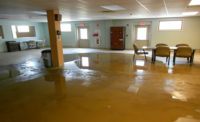Case Study Contest Winners
They told their stories, you voted!
















The Case Study Contest is over, and the votes are counted. The contest was meant to put the industry’s work on display, and give readers a chance to vote on their favorite projects. During the month of April, the contest was a big hit on www.randrmagonline.com.
Twelve projects were submitted and varied widely from removing nine tons of waste from a home, to flood cleanup and asbestos abatement. We asked companies to sum up the project, identify the challenges, and the overall solution.
In all, 148 votes were cast. Here’s a look at the winner, and top two runners-up.
Winner: Project 9: Large Loss Water Damage Restoration
Votes: 74%
Company: Cleantec
In June of 2013, CLEANTEC did a mitigation and remediation job for The Arc, a national non-profit organization for people with intellectual and developmental disabilities, after a day habilitation center and seven homes in a small town were damaged during a major spring flood. The following spring, hundreds of miles away, another chapter of the same non-profit was hit by a flash flood. Three days later, another flash flood added another two feet of contaminated water to the already-flooded 26,000 square-foot facility in Penn Yan, New York.
Located 90 miles away in Liverpool, New York, CLEANTEC learned about the flooding and jumped into action. Recalling the project from the year before, senior restoration manager Mark Lamphear reached out to the non-profit and partnered with them to save the building.
As roads became passable, and the CLEANTEC team began to evaluate the damage, it became evident that this 100-year flood had done massive damage. A state of emergency was declared and four days passed before waters receded and remediation could finally begin.
The facility was comprised of 65 offices, a commercial printing shop, a health clinic, community rooms, food service facilities, a community activity room, numerous restrooms and other areas all with saturated drywall, contaminated furnishings, and mud. It had been sitting for five days without power, the walls were wet, the building was full of office furnishings and personal items which were wet, carpet and laminate floors were full of water and mud, and it was mid-May — the seasonal heat and humidity on the rise.
The immediate action plan was to reduce the humidity inside the building, and get the mud and wet items out –fast. It was easier said than done. The basics of large loss catastrophic restoration management all became very real, very quickly. Manpower, fuel, food and water, dumpsters and other basics taken for granted in suburban and city environments had to be brought into the rural area to begin remediation.
With the help of many partners, dozens of workers were brought in, dumpsters donated, 100 air movers running, and the cleanup process underway. Staff shoveled, wet vacuumed, used squeegees, mopped and hosed out the mud. Beginning on one end of the building, teams moved room to room, emptying the wet contents. A second team followed with tape measures and chalk line snapping a guideline exactly 24.5 inches from the floor across every wall. The third team used a variety of hand and power tools to cut the drywall on clean, straight lines. The final team disengaged the drywall from the studs, bagged and hauled it to the dumpsters. This process went on for several days as the dehus and fans were removing moisture from structural items and the concrete floor slab.
The entire building was cleaned three times, including each metal wall stud. The hygienist sampled surfaces and cultured the results to determine the presence of E Coli, fecal coliforms, and Enterococcus bacteria. Finally, the building was clean and dry.
The damage exceeded the limits of The Arc’s insurance, and FEMA funds were unclear. The small non-profit organization was financially strapped to stay in operation through the crisis. CLEANTEC proceeded slowly with collecting payment for the work, and took partial payments throughout the rest of the year so the organization could still direct operating funds toward serving clients.
More than one year after the flood, the process with FEMA is slow. The Arc hopes to have renovations done by this August.
To read this full case study, and to see more photos of the project, click here.
First Runner-up
Project 8: Restoring Nancy O’Dell’s (of Entertainment Tonight) House
Votes: 14%
Company: Allied Restoration
When the economy tanked in 2008, Allied Restoration was just getting off the ground. After some major setbacks, the team sat down to decide what’s next. The answer: become the “Restoration Contractor to the Stars.” Allied Restoration planned to use their impeccable customer service to build a base of clients who counted on being treated well, and also paid their bills on time.
One of the first big clients they served was Nancy O’Dell, current co-anchor of Entertainment Tonight, former Miss South Carolina and former Miss America contestant. There was a leak somewhere near or in an upstairs bathroom. That leak was threatening the original hardwood ceiling in her 1930’s home, which she cherished. Allied Restoration says O’Dell had called in other emergency services companies who couldn’t find the leak, but using thermal cameras, they found it without a problem and also outlined a way to fix the problem from above, therefore saving the historical ceiling. Blown away by their customer service, O’Dell hired Allied Restoration for the entire project, and has hired them on other projects since.
Allied Restoration says their repertoire of wealthier clients means they increased their sales by 40 percent in 2014 alone.
Second Runner-up (a tie!)
Project 11: Asbestos Abatement on a WWII Destroyer
Votes: 4%
Company: Mill City Environmental Corporation
Removing asbestos from homes and commercial buildings is a common practice. Removing it from inside a historic naval vessel is not, but that didn’t stop Mill City Environmental Corporation from stepping up to the plate.
In September 2012, the National Park Service approached MCE to abate asbestos and clean 18 fuel tanks on the USS Cassin Young. The WWII destroyer is a museum at the Charlestown Navy Yard, but needed hull repairs so MCE prepped those areas for the Navy to perform the maintenance.
Due to the tight quarters, MCE used some creative engineering to dismantle parts of the vessel to get to the asbestos, while preserving the vessel’s historical integrity. They also removed fuel that had been sitting in the tanks since 1960. In every step, extra precautions were taken to ensure MCE could properly reassemble the parts of the ship on which they worked.
The four-month project was completed on time and on budget, and the National Park Service was so impressed they said, “you could practically eat off the floors in the tanks after MCE was done.”
Project 6: Removing Nine Tons of Waste
Votes: 4%
Company: Mastertech Environmental
Two companies had already turned down a toxic clean-up project before Mastertech Environmental was approached about the job: clear more than 20 years of bagged human waste from a two-bedroom New Jersey home. Plus, they had to dig a path to where the occupant, an elderly man, had died about three weeks earlier so his body could be removed.
Once the man’s body was removed, crews came in with snow shovels and trash carts. Eight workers removed piles so air scrubbers could be brought in, and the entire house put under negative air pressure. In some areas, the waste was three-feet deep. When it was all out, all surfaces were disinfected and scrubbed three times. Plus, ozone was used for four 12-hour periods to help with the odors that remained.
Looking for a reprint of this article?
From high-res PDFs to custom plaques, order your copy today!













